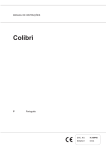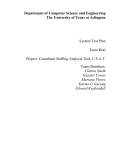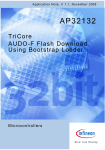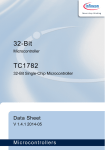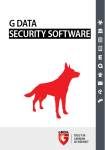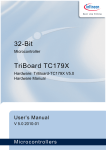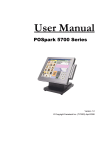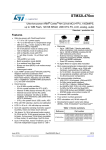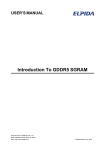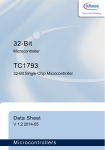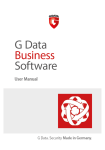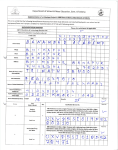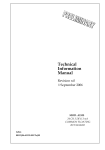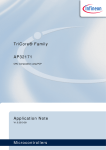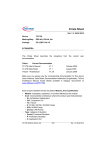Download Audo Future/Audo NG - Delta Specification
Transcript
Delta Specification, V1.0, Dec. 2006 Audo Future/Audo NG 32-Bit Single-Chip Microcontroller Microcontrollers Edition 2006-12 Published by Infineon Technologies AG 81726 München, Germany © Infineon Technologies AG 2006. All Rights Reserved. Legal Disclaimer The information given in this document shall in no event be regarded as a guarantee of conditions or characteristics (“Beschaffenheitsgarantie”). With respect to any examples or hints given herein, any typical values stated herein and/or any information regarding the application of the device, Infineon Technologies hereby disclaims any and all warranties and liabilities of any kind, including without limitation warranties of noninfringement of intellectual property rights of any third party. Information For further information on technology, delivery terms and conditions and prices please contact your nearest Infineon Technologies Office (www.infineon.com). Warnings Due to technical requirements components may contain dangerous substances. For information on the types in question please contact your nearest Infineon Technologies Office. Infineon Technologies Components may only be used in life-support devices or systems with the express written approval of Infineon Technologies, if a failure of such components can reasonably be expected to cause the failure of that life-support device or system, or to affect the safety or effectiveness of that device or system. Life support devices or systems are intended to be implanted in the human body, or to support and/or maintain and sustain and/or protect human life. If they fail, it is reasonable to assume that the health of the user or other persons may be endangered. Delta Specification, V1.0, Dec. 2006 Audo Future/Audo NG 32-Bit Single-Chip Microcontroller Microcontrollers Audo Future/Audo NG Delta Specification Revision History: V1.0 2006-12 Previous Version: V1.0 is the first released spec version Page Subjects (major changes since last revision) several see change bars Trademarks TriCore™ is a trademark of Infineon Technologies AG. We Listen to Your Comments Any information within this document that you feel is wrong, unclear or missing at all? Your feedback will help us to continuously improve the quality of this document. Please send your proposal (including a reference to this document) to: [email protected] Template: mc_a5_um_tmplt.fm / 4 / 2004-09-15 Audo Future/Audo NG Table of Contents Table of Contents This “Table of Contents” section refers to the page numbers of the Audo Future/Audo NG Delta Specification. 1 Introduction . . . . . . . . . . . . . . . . . . . . . . . . . . . . . . . . . . . . . . . . . . . . 1-1 [1] 2 2.1 2.2 2.3 2.4 2.5 2.6 2.7 2.8 2.9 2.10 2.11 2.12 2.13 2.14 2.15 System Units . . . . . . . . . . . . . . . . . . . . . . . . . . . . . . . . . . . . . . . . . . . 2-1 [1] Pinning . . . . . . . . . . . . . . . . . . . . . . . . . . . . . . . . . . . . . . . . . . . . . . . . . 2-1 [1] CPU . . . . . . . . . . . . . . . . . . . . . . . . . . . . . . . . . . . . . . . . . . . . . . . . . . . 2-4 [1] SCU . . . . . . . . . . . . . . . . . . . . . . . . . . . . . . . . . . . . . . . . . . . . . . . . . . . 2-5 [1] On-Chip System Buses and Bus Bridges . . . . . . . . . . . . . . . . . . . . . . 2-6 [1] PMU . . . . . . . . . . . . . . . . . . . . . . . . . . . . . . . . . . . . . . . . . . . . . . . . . . . 2-7 [1] Data Access Overlay . . . . . . . . . . . . . . . . . . . . . . . . . . . . . . . . . . . . . . 2-8 [1] BootROM . . . . . . . . . . . . . . . . . . . . . . . . . . . . . . . . . . . . . . . . . . . . . . . 2-9 [1] Memory Maps . . . . . . . . . . . . . . . . . . . . . . . . . . . . . . . . . . . . . . . . . . . 2-9 [1] GPIO Ports and Peripheral I/O . . . . . . . . . . . . . . . . . . . . . . . . . . . . . 2-10 [1] PCP . . . . . . . . . . . . . . . . . . . . . . . . . . . . . . . . . . . . . . . . . . . . . . . . . . 2-10 [1] DMA . . . . . . . . . . . . . . . . . . . . . . . . . . . . . . . . . . . . . . . . . . . . . . . . . . 2-11 [1] EBU . . . . . . . . . . . . . . . . . . . . . . . . . . . . . . . . . . . . . . . . . . . . . . . . . . 2-12 [1] Interrupt System . . . . . . . . . . . . . . . . . . . . . . . . . . . . . . . . . . . . . . . . 2-13 [1] System Timer . . . . . . . . . . . . . . . . . . . . . . . . . . . . . . . . . . . . . . . . . . . 2-13 [1] On-Chip Debug Support . . . . . . . . . . . . . . . . . . . . . . . . . . . . . . . . . . 2-14 [1] 3 3.1 3.2 3.3 3.4 3.5 3.6 3.7 3.8 3.9 Peripheral Units . . . . . . . . . . . . . . . . . . . . . . . . . . . . . . . . . . . . . . . . . ASC . . . . . . . . . . . . . . . . . . . . . . . . . . . . . . . . . . . . . . . . . . . . . . . . . . . SSC . . . . . . . . . . . . . . . . . . . . . . . . . . . . . . . . . . . . . . . . . . . . . . . . . . . MultiCAN . . . . . . . . . . . . . . . . . . . . . . . . . . . . . . . . . . . . . . . . . . . . . . . MSC . . . . . . . . . . . . . . . . . . . . . . . . . . . . . . . . . . . . . . . . . . . . . . . . . . . MLI . . . . . . . . . . . . . . . . . . . . . . . . . . . . . . . . . . . . . . . . . . . . . . . . . . . . GPTA . . . . . . . . . . . . . . . . . . . . . . . . . . . . . . . . . . . . . . . . . . . . . . . . . . ERAY . . . . . . . . . . . . . . . . . . . . . . . . . . . . . . . . . . . . . . . . . . . . . . . . . . ADC . . . . . . . . . . . . . . . . . . . . . . . . . . . . . . . . . . . . . . . . . . . . . . . . . . . FADC . . . . . . . . . . . . . . . . . . . . . . . . . . . . . . . . . . . . . . . . . . . . . . . . . . Delta Specification I-1 3-1 [2] 3-1 [2] 3-1 [2] 3-1 [2] 3-1 [2] 3-1 [2] 3-2 [2] 3-4 [2] 3-4 [2] 3-4 [2] V1.0, 2006-12 Audo Future/Audo NG 1 Introduction Introduction The Delta Specification highlights the main functional differences or enhancements between Infineon Audo Future and Audo NG. The reference documents for this document are: • • • • • • • TC1797 Target Specification, V1.2, Dec. 2006 TC1767 Target Specification, V1.2, Dec. 2006 TC1796 System and Peripheral Units User’s Manual (Vol.1 and 2), V1.0, June 2005 TC1796 Documentation Addendum, V1.1, Sept. 2006 TC1766 System and Peripheral Units User’s Manual (Vol.1 and 2), V1.1, Aug.2005 TC1766 Documentation Addendum, V1.1, Oct. 2006 Errata Fix Matrix, TC1796_BE_TC1797_bugfix_V13_external.xls Delta Specification 1-1 V1.0, 2006-12 Audo Future/Audo NG 2 System Units System Units This section highlights the main functional differences or enhancements for the system units between Infineon Audo Future and Audo NG. 2.1 Pinning Figure 2-1 shows the differences of the pinning for TC1797/TC1796: Delta Specification 2-1 V1.0, 2006-12 Figure 2-1 Delta Specification 2-2 AN6 AD AN33 AN1 AN4 2 AN8 AC AN9 1 AN12 AB AN11 AN37 AN15 AA AN14 AN17 AN0 AN18 Y N.C. AN20 W P7.7 AN21 AF AN22 V P7.5 P7.1 P1.1 P1.7 P1.9 P6.13 P6.10 P6.11 P2.3 3 AN39 AN36 AN34 AN32 AN3 AN5 AN10 AN13 AN19 P7.3 P7.4 P7.0 P1.0 P1.6 P1.8 P1.13 P8.6 P8.2 VDDFL3 P6.7 P6.4 P6.6 P2.2 P2.11 P2.10 P2.13 Topview 4 AN43 AN41 AN40 AN38 AN7 AN2 VSSM VDDM AN16 P7.2 VSS VDD P1.12 P1.4 P1.5 P1.11 VDDP VSS VDD P6.5 P6.8 P6.9 P0.15 P2.12 P2.14 P2.15 5 VAGND0 VAREF0 AN35 AN42 P0.13 P0.12 P0.9 P0.14 6 AN29 AN28 VAREF1 VAGND1 green orange blue grey VDDP P0.8 P0.4 P0.2 VSS P0.7 P0.3 P0.1 P0.0 VDD P3.7 P3.15 VSS VSS VSS VSS VSS VSS VSS VSS P3.8 P3.10 P3.6 P3.14 7 AN31 AN30 AN27 AN26 8 VFAREF VFAGND AN25 AN24 VDDAF 9 VSSMF VDDMF VAREF2 additional functions 10 P4.6 P4.1 P4.0 VSS changed or removed functions port-mapped no change Legend: P0.11 P0.10 P0.6 P0.5 Version 1.2 11 P4.9 P4.3 P4.2 VDD VSS VSS VSS VSS VSS VSS VSS VSS P3.12 P3.9 P3.3 P3.5 12 P4.10 P4.7 P4.5 P4.4 VSS VSS VSS VSS VSS VSS VSS VSS P3.13 P3.4 P3.0 P3.1 13 P4.14 P4.13 P4.11 P4.8 VSS VSS VSS VSS VSS VSS VSS VSS P3.11 P3.2 P5.0 P5.1 14 P10.3 P10.4 P4.15 P4.12 VSS VSS VSS VSS VSS VSS VSS VSS VDDP P5.5 P5.3 P5.2 15 P10.1 P10.0 P10.2 P10.5 VSS VSS VSS VSS VSS VSS VSS VSS VSS P5.4 P5.6 P5.7 16 VDDP VDDP VDDP VDDP VSS VSS VSS VSS VSS VSS VSS VSS VDD P5.9 P5.13 P5.12 17 P16.0 P15.4 P15.5 VSS VSS VSS VSS VSS VSS VSS VSS VSS P5.8 P5.10 P5.14 P5.15 18 P15.6 P15.7 P16.1 VDDEBU P9.4 P5.11 VDDFL3 VDDFL3 19 P15.12 P16.3 P15.3 VSS P9.5 P9.6 P9.1 P9.0 20 P15.8 P15.11 P15.2 VDD P9.7 P9.8 P9.2 P9.3 P9.9 21 P15.9 P15.0 P15.1 N.C. P9.12 P9.11 P9.10 ESR1 22 P15.10 N.C. P16.2 VDDEBU VDDP N.C. PORST ESR0 23 P15.13 N.C. N.C. VSS VDD P14.3 VDDEBU VSS VDD P13.6 VDDEBU VSS VDD P11.13 VDDEBU VSS P11.7 P11.3 VDDEBU VDDPF TRST VDD VSS VDDP TESTMODE N.C. 24 P15.14 P14.14 P14.15 P14.12 P14.5 P14.6 P14.2 P14.0 P13.13 P13.9 P13.1 P12.3 P12.1 P11.14 P11.10 P11.11 P11.4 P12.6 VDDEBU VDDPF3 TMS TCK VDD VSS VDDP 25 P15.15 P14.13 P14.11 P14.9 P14.4 P14.1 P13.14 P13.12 P13.8 P13.5 P13.3 P12.5 P12.2 P11.15 P11.9 P11.5 P11.1 P12.7 VDDEBU XTAL2 VSSOSC TDI TDO VDD VSS VDDP VSS 26 N.C. P14.10 P14.8 P14.7 P13.15 P13.11 P13.10 P13.7 P13.4 P13.2 P13.0 P12.4 P12.0 P11.12 P11.8 P11.6 P11.2 P11.0 VDDEBU XTAL1 VDDOSC VDDOSC3 P9.14 P9.13 VDD AE AN23 U P1.10 P7.6 P1.15 L M VDDE(sb) P8.7 T P8.4 J K R P8.1 H P1.2 P1.14 P6.15 G P1.3 P8.5 P6.14 F P P8.3 P6.12 E N P8.0 P2.4 D P2.8 P2.5 C P2.7 P2.9 P2.6 N.C. B A Changes to TC1796 Audo Future/Audo NG System Units TC1797/TC1796 Pinning for P-BGA-416 Package V1.0, 2006-12 AN1 9 AN1 8 AN1 7 AN1 6 AN1 5 AN1 4 VAGND0 VAREF0 V SSM V DDM AN1 3 AN1 2 AN1 1 AN1 0 A N9 A N8 A N6 A N5 A N4 A N3 A N2 A N1 A N0 V DD VDDP VSS A D0E M UX2 /OUT 18/IN1 8/P 1.1 4 A D0E M UX1 /OUT 17/IN1 7/P 1.1 3 A D0E M UX0 /OUT 16/IN1 6/P 1.1 2 TCLK 0 /OUT2 8/OUT 32/ IN32/P 2. 0 SL SO 13/S LS O0 3/OUT 33/ TRE A DY0 A/ IN33/P 2. 1 T VA LID0 A /OUT2 9/OUT 34/ IN34/P 2. 2 TDA TA 0 /OUT3 0/OUT 35/ IN54/P 2. 3 O UT31 /OUT 36/RCL K0 A/ IN36/P 2. 4 RRE ADY 0A /O UT37 /OUT 110/ IN37/P 2. 5 OUT 38 /OUT1 11/RV A LID0 A/ IN38/P 2. 6 OUT 39/RDA T A0 A/ IN39/P 2. 7 VSS VDDP V DD VSS OUT 52/OUT 28 /IN52/ IN28/P 4. 0 OUT 53/OUT 29 /IN53/ IN29/P 4. 1 E X TCL K1 /OUT 54/OUT 30 /IN54/ IN30/P 4. 2 45 46 47 48 49 50 51 52 53 54 55 56 57 58 59 60 61 62 63 64 65 66 67 68 69 70 71 72 73 74 75 76 77 78 79 80 81 82 83 84 85 86 87 88 OUT 40/OUT 8/IN40/IN26/P5.0 OUT 41/OUT 9/IN41/IN27/P5.1 OUT 42/OUT 10/IN42/IN28/P5.2 OUT 43/OUT 11/IN43/P5.3 OUT 44/OUT 12/IN44/IN29/P5.4 OUT 45/OUT 13/IN45/IN30/P5.5 OUT 46/OUT 14/IN46/IN31/P5.6 OUT 47/OUT 15/IN47/P5.7 T CLK0/OUT 95/P5.15 VDD V DDP V SS RDAT A0B/OUT 89/P5.8 RVALID0B/OUT 90/P5.9 RREADY0B/OUT 91/P5.10 RCLK0B/OUT 92/P5.11 T DAT A0/SLSO07/OUT 93/P5.12 T VALID0B/SLSO16/P5.13 T READY0B/OUT 94/P5.14 V DDP V DD(SB) V SS V DDAF VDDMF V SSMF VFAREF V FAGND AN35 AN34 AN33 AN32 AN31 AN30 AN29 AN28 AN7 AN27 AN26 AN25 AN24 AN23 AN22 AN21 AN20 Figure 2-2 Delta Specification 1 2 3 4 5 6 7 8 9 10 11 12 13 14 15 16 17 18 19 20 21 22 23 24 25 26 27 28 29 30 31 32 33 34 35 36 37 38 39 40 41 42 43 44 17 6 17 5 17 4 17 3 172 171 170 169 168 167 166 16 5 16 4 16 3 162 161 160 159 158 157 156 155 154 153 15 2 15 1 15 0 14 9 14 8 147 14 6 14 5 14 4 14 3 14 2 14 1 14 0 13 9 13 8 137 13 6 13 5 13 4 13 3 P 0. 15/I N15/RE Q5/ OUT1 5/OUT 71 P 0. 14/I N14/RE Q4/ OUT1 4/OUT 70 P 0. 7/IN7 /HW CFG7 /REQ 3/OUT 7/OUT 63 P 0. 6/IN6 /HW CFG6 /REQ 2/OUT 6/OUT 62 V SS V DDP V DD P 0. 13/I N13/OUT 13 /OUT6 9 P 0. 12/I N12/OUT 12 /OUT6 8 P 0. 5/IN5 /HW CFG5 /OUT5 /OUT 61 P 0. 4/IN4 /HW CFG4 /OUT4 /OUT 60 P 2. 13/I N13/OUT 3/S LS I1 1/S DI0 P 2. 8/S LS O04 /S LS O14/ EN0 0 P 2. 12/I N12/OUT 2/M TS R1A /S OP 0B P 2. 11/I N11/OUT 1/S CLK 1A /F CLP 0B P 2. 10/I N10/OUT 0/M RS T1A P 2. 9/S LS O05 /S LS O15/ EN0 1 P 6. 3/IN2 5/OUT 7/OUT 83/ SO P0 A P 6. 2/IN2 4/OUT 6/OUT 82/ SO N0 P 6. 1/IN1 5/OUT 5/OUT 81/ FCLP 0A P 6. 0/IN1 4/OUT 4/OUT 80/ FCLN0 V SS V DDP V DD P 0. 11/I N11/OUT 11 /OUT6 7 P 0. 10/I N10/OUT 10 /OUT6 6 P 0. 9/IN9 /OUT9 /OUT 65 P 0. 8/IN8 /OUT8 /OUT 64 P 0. 3/IN3 /HW CFG3 /OUT3 /OUT 59 P 0. 2/IN2 /HW CFG2 /OUT2 /OUT 58 P 0. 1/IN1 /HW CFG1 /OUT1 /OUT 57 P 0. 0/IN0 /HW CFG0 /OUT0 /OUT 56 P 3. 11/O UT93 /RE Q1 P 3. 12/O UT94 /RX DCAN0 /RXD0 B P 3. 13/O UT95 /TX DCA N0/T X D0 V DDFL3 V SS V DDP P 3. 9/OUT 91/ RXD1 A P 3. 10/O UT92 /RE Q0 P 3. 0/OUT 84/ RXD0 A P 3. 1/OUT 85/ TX D0 P 3. 14/O UT96 /RX DCAN1 /RXD1 B P 3. 15/O UT97 /TX DCA N1/T X D1 Audo Future/Audo NG System Units Figure 2-2 shows the differences of the pinning for TC1767/TC1766: TC1767 Changes from T C1766: grey blue orange green 2-3 no change port-m apped changed or rem oved functions additional functions 132 131 130 129 128 127 126 125 124 123 122 121 120 119 118 117 116 115 114 113 112 111 110 109 108 107 106 105 104 103 102 101 100 99 98 97 96 95 94 93 92 91 90 89 P3.4/OUT 88/MT SR0 P3.7/SLSI01/OUT 89/SLSO02/SLSO12 P3.3/OUT 87/MRST 0 P3.2/OUT 86/SCLK0 P3.8/SLSO06/OUT 90/T XD1 P3.6/SLSO01/SLSO11/SLSO01&SLSO11 P3.5/SLSO00/SLSO10/SLSO00&SLSO10 V SS VDDP VDD ESR0 PORST ESR1 P1.1/IN17/OUT 17/OUT 73 T EST MODE P1.15/BRKIN/BRKOUT P1.0/IN16/OUT 16/OUT 72/BRKIN/BRKOUT T CK/DAP0 T RST T DO/DAP2/BRKIN/BRKOUT T MS/DAP1 T DI/BRKIN/BRKOUT P1.7/IN23/OUT 23/OUT 79 P1.6/IN22/OUT 22/OUT 78 P1.5/IN21/OUT 21/OUT 77 P1.4/IN20/EMGST OP/OUT 20/OUT 76 VDDOSC3 VDDOSC VSSOSC XT AL2 XT AL1 V SS VDDP V P1.3/IN19/OUT 19/OUT 75 P1.11/IN27/IN51/SCLK1B/OUT 27/OUT 51 P1.10/IN26/IN50/OUT 26/OUT 50/SLSO17 P1.9/IN25/IN49/MRST 1B/OUT 25/OUT 49 P1.8/IN24/IN48/MT SR1B/OUT 24/OUT 48 P1.2/IN18/OUT 18/OUT 74 V SS V DDP P4.3/IN31/IN55/OUT 31/OUT 55/EXT CLK0 V DD DD MCP06067_d TC1767/TC1766 Pinning for PG-LQFP-176-x Package V1.0, 2006-12 Audo Future/Audo NG System Units 2.2 CPU The main differences of the CPU for Audo Future as compared to Audo NG are based on the following points: • • • • • • • • • • • • • • TriCore 1.3.1 is User mode backwards compatible to TC1.3. The cycle timing may change slightly due to microarchitectural performance improvements. Backwards-compatible from the Supervisor mode perspective, except for the FPU interrupt which turned into an CAE trap (trap vector table instead of interrupt vector table). Introduction of a 128-bit Data Line Buffer within LMB interface of DMI, increasing performance of accesses to cacheable addresses. Enhanced Data Cache manipulation support with the introduction of new DCACHE instructions CACHEI.W (Cache Index, Write Back) & CACHEI,WI (Cache Index, Write Back, Invalidate). Improved instruction fetch system with small dynamic branch predictor. The usage of old/new branch prediction behavior can be selected via a control register bit. Improved debug support including upgraded OCDS Level 3 trace port and performance counters. Dedicated performance counters capture CPU clocks, Instruction Count, Instruction Cache Hit/Miss and Data Cache Hit/Miss (clean or dirty). Increased flexibility in the system address map. PMI Sratchpad SRAM is relocated from C4000000H to C0000000 H in order to support absolute addressing within the first 16 KByte. Improved Floating-Point Unit supporting flexible C compatible conversion functions and improved exception handling. The usage of old/new FPU behavior can be selected via control register bit. Faster Integer MAC/MUC execution unit (all instructions have single-cycle repeat rate and a latency of 2). Reduced TriCore Power Consumption. Introduction of Data Cache. Configurable size of Instruction Cache and Data Cache. Byte write support from LMB to SPRAM. Removed DMI data input register stage between LMB and DMI data input. Delta Specification 2-4 V1.0, 2006-12 Audo Future/Audo NG System Units 2.3 SCU The main differences of the SCU for Audo Future as compared to Audo NG are based on the following points: • • • • • • • • • • • • • • • • • • The Clock Generation Unit consists of the oscillator circuit, PLL and an additional Clock Control Unit. It provides clocks which can configured accordingly. 2 external clock outputs pins are available. Hardware support for GPTA counter to detect an up-and-stable crystal. Oscillator Run Detection includes an Oscillator Watchdog which monitors the input frequency where the expected input frequency is configurable. During PLL VCO Loss-of-Lock event, the oscillator can be configured to remain connected to the VCO. Two K-dividers are available, K1 is defined for Normal and Freerunning Mode and K2 for Prescaler Mode. New reset model for power-on reset, system reset, debug reset and application reset and EEC reset. Reset counters ensures a configurable minimum length of reset. Reset triggers lead to specific, configurable or no reset. Only 10 pins are needed for boot option control. ESR pins are introduced to trigger a reset, a trap (NMI), a reset output or as data pin. Die temperature sensor is independent from other internal resources (ADC) and no specific power supply is needed. Enhanced debug support for the Watchdog Timer. FPU interrupts are no longer processed in the SCU where they are shifted to CPS. Flexible interrupt and trap handling in the SCU. Pad Test Mode is replaced by boundary scan. Pad Driver Temperature Compensation Control is removed. EBU pull-up control is performed through the port control. Delta Specification 2-5 V1.0, 2006-12 Audo Future/Audo NG System Units 2.4 On-Chip System Buses and Bus Bridges The main differences of the On-Chip System Buses and Bus Bridges for Audo Future as compared to Audo NG are based on the following points: • • • • • • • • • • The Audo Future is based on two on chip busses (LMB , SPB). The remote peripheral bus (RPB) is removed. The DMA is additionally connected to the LMB bus with a master interface. In TC1797, the Flexray module is additionally connected to the SPB with a slave interface. The OCDS module is connected to the DMA. The OCDS module has direct access to the LMB/SPB bus via the DMA-LMB and DMA-SPB master interface. DMA decides to forward transactions from DMA internal sources (Move Engine 0/1, MLI0/1 and Cerberus) to LMB/SPB by internal address decoding. The DMA controller can generate single data read and write transactions on the LMB bus. The DMA does not forward directly transactions from the FPI bus to the LMB bus or vice versa (no LMB<->FPI bridge functionality). Further DMA details and/or DMA changes compared to AudoNG can be found in the DMA chapter. The DMA module is now able to access the LMB / SPB bus with three priorities. Priority of DMA access is controlled by the OCDS (for DMA-OCDS accesses) and by the Move Engine Channels for DMA-Move Engine accesses. The LMB-to-FPI bridge (LFI) address translation table was adapted to the AudoFuture address space. A new SBCU_DBDAT register is introduced for enhanced OCDS Level 1. The table On Chip Bus Master TAG Assignments is adapted. Delta Specification 2-6 V1.0, 2006-12 Audo Future/Audo NG System Units 2.5 PMU The main differences of the PMU for Audo Future as compared to Audo NG are based on the following points: • • • • • • • • • • • • • • • • • • • With an additional 2 MByte Flash module in TC1797, concurrent write and read operations are supported with both Flash modules (2 x 2Mbyte). Sectorization is changed where each 512 KByte sectors (the 480 KByte sector in TC1766 inclusive) in PFlash is replaced by 2x256 KByte sectors. The 128 KByte sector for 8 logical sectors (only in TC1766) is replaced by 2x64 Kbyte sectors. Read protection can be excluded for Data Flash in Audo Future. Verify and operation error interrupt can be generated in Audo Future. Wait states for read access to PFlash and DFlash is supported up to fifteen clock cycles in Audo Future as compared to seven clock cycles in Audo NG. The FSI recovery is fully controlled by the FSI in Audo Future/TC1766 as compared to the control by PMU in TC1796. Dynamic power reduction where idle states can be used to disable the wordline drivers in PFlash. A wordline in PFlash can also be invalidated in addition to invalidation stamp of only DFlash. The Flash interrupt control register is located in the SCU for Audo Future as compared to the location in the DMA controller in Audo NG. If read protection is active in Audo Future, the user has to install the SPR/cache configuration after reset to lock the configuration (enable protection) to disable data read accesses to the instruction cache. If read protection is active in Audo NG, any data read access to the instruction cache is disabled after reset by the dedicated logic. If page buffer is not full, sequence error can be generated with Write Page command. Global sleep request from SCU is supported. PFlash instruction access (inclusive of non-cached mode) is four double-word bursts. For cached data read access to the Program Flash in Audo Future, the transfer of the aligned two double-word block starts with the critical(addressed) double-word compared to the lowest double-word of the TC1796. Direct Flash read access from Debug Interface is improved as there is no LFI bridge delay and same addressing as CPU side. OVRAM is parity-protected. In Emulation Device, base address of 256 Kbyte EMEM is identical to the 512 Kbyte base address. New OLDA function with virtual memory range in PMU for callibration data acquisition and for redirection to overlay memory. New OVRCON register in PMU. Overlay function control is located in DMI for Audo Future as compared to the control in PMU in Audo NG. Delta Specification 2-7 V1.0, 2006-12 Audo Future/Audo NG System Units 2.6 Data Access Overlay The main differences of the Data Access Overlay for Audo Future as compared to Audo NG are based on the following points: • • • • • • • • • • • • All OVC register addresses are shifted into the CPU space. A virtual memory range provided in PMU can be additionally used for redirection to overlay memory. If the chip is an emulation device, the external memory can also be used as overlay memory. All configured overlay blocks can be enabled or disabled with one register access, a set of overlay blocks can be exchanged with another set of prepared blocks in one step. Programmable flush (invalidate) control for data cache in DMI is available in Audo Future. Overlay configured status bit can be set when overlay registers are configured by the Cerberus via JTAG interface. This bit can be used as handshake signal for Cerberus/CPU to start the prepared overlay blocks. New OCON register for control of overlay functions. Minimum overlay block size increased to 16 Bytes in Audo Future as compared to 2 in Audo NG. Additional block sizes in OVRAM of 1KByte and 2 KByte. Additional sizes of overlay blocks of 64 KByte and 128 KByte in EMEM. All EMEM block sizes are supported for external overlay memory. Flash size above 2 MByte is supported for overlay control. Support of different overlay memory selections for every enabled memory block in Emulation Device. Delta Specification 2-8 V1.0, 2006-12 Audo Future/Audo NG System Units 2.7 BootROM The main differences of the BootROM content for Audo Future as compared to Audo NG regarding the device boot-operation (controlled by the Startup Software) from user point of view are based on the following points: • • The Startup mode selection is done by – Audo Future - between 2 (for Internal Start) and 8 (for External Start modes) P0 pins (out of P0[7:0]) – Audo NG - HWCFG[3:0] + SWOPT[7:0] + BRKIN (a total of 12 pins) Bootstrap Loader via CAN pins can use either ASC or CAN protocol; the exact type of communication protocol is – Audo Future - automatically detected by the Startup Software – Audo NG - selected via configuration pins. 2.8 Memory Maps The general target for the Audo Future devices is to keep the address map compatible with the Audo NG devices where ever possible. As a result, most of the start addresses of the SRAMs, Flash segments and the peripheral control register sets of TC1767 and TC1797 are identical to TC1766 and TC1796, respectively. The main differences of the memory map for Audo Future as compared to Audo NG are based on the following points: • • • • • • • • • • • • • Address map is adapted to the peripheral set of the products (peripherals where added/removed, number of ports is adapted). Target was to keep the start address where possible of all common modules, SRAMs and Flash segments. Added PMI Byte Read/Write access. Added Double-Word support for PCP-CRAM and PCP-PRAM accesses where CPU has also 64 bit access to the PCP memories. Moved SCU address map inside Segment 15 as SCU requires 2x256Byte in Audo Future. Moved ADC and FADC address maps inside Segment 15 as these modules require more 256 byte slices in Audo Future. Adapted memory and flash sizes (SPRAM, LDRAM, CRAM, PRAM, PFlash, DFlash) OVRAM is moved from Segment 12 to Segment 8 and Segment 10. Emulation Device Memory was moved from xFF2-0000 -> xFF5FFF to xFF0-0000 > xFF3-FFFF. An PMI memory mirror image was added (SPRAM + configurable ICACHE) to C000. Added map of the mirrored PMI memory image to segment E800. Removed Boot ROM Address Space in segment D as it is not necessary any more in Audo Future. Added Online Data Acquisition Address Space (OLDA) to segment 8 and A. MultiCAN module address space increased from 8KB -> 16KB. Delta Specification 2-9 V1.0, 2006-12 Audo Future/Audo NG System Units • Changed the SPB view of segment C and D in a way that it is now fully transparent (write accesses to reserved addresses result in LMBBE, read to SPBBE & LMBBE) Added Overlay Control Module (OVC) with 256 byte to segment 15 as this functionality is moved now to DMI. • 2.9 GPIO Ports and Peripheral I/O The main differences of the GPIO ports and peripheral I/O for Audo Future as compared to Audo NG are based on the following points: • The EBU signals are controlled in the ports. The hardware-controlled signals override the priority of the software-configured port pin direction (input or output) and signal source (EBU or Alternate Outputs). 2.10 PCP The main differences of the PCP for Audo Future as compared to Audo NG are based on the following points: • • • Enhanced PCP core to support higher clock frequencies. Multiple clock ratios PCP:FPI 1:1 and 2:1. Improvement of PCP Trace Interface to MCDS. Delta Specification 2-10 V1.0, 2006-12 Audo Future/Audo NG System Units 2.11 DMA The main differences of the DMA for Audo Future as compared to Audo NG are based on the following points: • • • • • • • • • • • A new mode for the shadow address register was introduced to support endless channel re-starts without CPU intervention. In this new mode, the shadow address register can be written directly and it is not re-set automatically when loaded into target or destination address register. The new Shadow Register Write Enable bit was added to the register DMA_ADRCR1/0x. The DMA channels are supporting now transactions with data moves > 32 KB (bit fields CHCR.TREL and CHSR.TCOUNT are extended to 10 bit. As a central module of the AudoFuture system on chip architecture, the DMA is now directly connected to the LMB with an own LMB master interface. The DMA master interface to the RPB was removed as the AudoFuture system architecture is based on a single LMB and single FPI (SPB) bus. The RPB BCU control registers were removed as there is no remote peripheral bus in AudoFuture. The Cerberus module is now connected to the DMA Peripheral Interface. This enables the Cerberus module to have direct access to the FPI and to the LMB bus via the DMA master interfaces either with the highest or with the lowest priority on LMB / FPI. 3-level programmable priority of the DMA Sub-Block at the on chip bus interfaces (2level in AudoNG). The bit field DMAPRIO is expanded to 2 bits in the Channel Control register to support the three DMA on chip bus priorities. The new structure is on the one hand compatible to the AudoNG channel priorities on the SPB, on the other hand it allows to use DMA channels for low priority background tasks on LMB like memory scrubbing. Additionally the DMA On Chip Bus priorities and the DMA bus switch priorities are adapted. The System Interrupt Registers are removed from the DMA module (moved to CPU PMU and SCU). The DMA module has 8 Service Requests nodes. DMA interrupt outputs DMA SR[7:0] are connected to interrupt nodes. SR[15:8] are used as DMA channel request inputs (DMA_SRCn (n = 0-7)). Up to 16 selectable request inputs per DMA channel (up to 8 in Audo NG). To allow a more flexible usage of the Move Engine Channels, the number of channel request inputs was increased to 16 (DMA_CHRC0x/1x.PRSEL expanded from 3 bit to 4 bit, and the DMA request wiring matrix was re-defined. Adapted the DMA access protection assignment to the Audo Future address map The address protection sub-ranges are mapped to OVRAM, LDRAM, SPRAM and PCP PRAM. In general the DMA control registers where adapted to the new structure in Audo Future (one FPI master interface and one LMB master interface instead of two FPI master interfaces). Delta Specification 2-11 V1.0, 2006-12 Audo Future/Audo NG System Units 2.12 EBU The main differences of the EBU for Audo Future as compared to Audo NG are based on the following points: • • • • • • • • • • • Registers remapped to simplify programming. A region can now be reconfigured with a single write. Each region can now have different settings for read and write accesses. This enables a region to be configured for synchronous, burst reads and asynchronous writes. This improves support for burst flash memories. Access latency when using the gated burst flash clocking mode has been reduced by two BFCLKO cycles. Prefetch buffer has been removed, along with byte addresses on the external bus (i.e. the previously implemented BUSCON.AALIGN bit is now permanently active) and big-endian support. 1) Access pipelining has been improved, allowing increased utilisation of the external bus. New feature, "chip select locking" added to simplify burst flash programming. Unused EBU pads are now available for use as GPIO. 1:3 clock mode for generating BFCLKO now results in a clock with a 50% duty cycle. EBU clock can now be disabled if the EBU is not required for a significant time period. Automatic wakeup when accessed Support for industrial memories updated. Improved support for SSRAM, PSRAM and NAND flash memory types. EBU supports 16-bit multiplexed mode now. 1) As BUSCON.AALIGN bit has been removed, due to compatibility mode after reset for PCB design, a ballout change have been implemented (A0 ← A22, A1 ← A23, A2 ← A0, A3 ← A1, …) in order to support combi layouts for TC1796 and TC1797 derivatives in BGA416 package in combination with 32-bit external memory devices. Delta Specification 2-12 V1.0, 2006-12 Audo Future/Audo NG System Units 2.13 Interrupt System The main differences of the interrupt system for Audo Future as compared to Audo NG are based on the following points: • The System Interrupt Registers are moved from DMA module to CPU, PMU and SCU modules. 2.14 System Timer The main differences of the system timer for Audo Future as compared to Audo NG are based on the following points: • • The STM registers can be excluded from application reset if configured. The 2 service request outputs are additionally connected to ADC and DMA modules and allow triggering requests in these modules. Delta Specification 2-13 V1.0, 2006-12 Audo Future/Audo NG System Units 2.15 On-Chip Debug Support The main differences of the On-Chip Debug Support for Audo Future as compared to Audo NG are based on the following points: • • • • • On-Chip Debug Support – Cerberus has direct access to the LMB bus. No address translation due to LFI, no SPB bus blocking. – Requesting all kinds of reset can now be done without usage of sideband pins. – Central Suspend Switch to suspend parts of the system (TriCore, PCP, Peripherals) instead if breaking them as reaction to a debug event. – Triggered Transfer of data in response to a debug event now if target is programmed to be a device interface simple variable tracing can be done. – In depth performance analysis and profiling support given by the Emulation Device through MCDS Event Counters driven by a variety of trigger signals (e.g. cache hit, wait state, interrupt accepted). Real Time Trace with ED only – OCDS Level 2 is not supported. – Additional Data Flow Trace on the LMB bus (only on FPI in the AudoNG devices). – Improved Instruction Trace for PCP and TC (‘’absolute mode”). PSW.PRS is traced separately. – Additional debug events based on comparators on all traced signals. – Accurate time stamping of all messages. Resolution is TriCore clock rate now up to 80 MHz, optionally half of it. – Programmable automatic suspend of the system when the trace buffer runs full for continuous trace. Calibration Support – Configuration change is triggered by a single SFR access to maintain consistency. – Invalidation of the Data Cache (maintaining write-back data) can be done concurrently with the same SFR. – A dedicated trigger SFR with 32 independent status bits is provided to centrally post requests from application code to the host computer. – The host is notified automatically when the trigger SFR is updated by the TriCore or PCP. No polling via a system bus is required. Tool Interfaces – Two-wire DAP protocol for long connections/noisy environments. – Three pin DAP configuration for high bandwidth applications. – USB currently not planned. – Bit clock up to 40 MHz for JTAG, up to 80 MHz for DAP (in 3-pin configuration). – BRKIN and BRKOUT pins can be mapped to unused JTAG pins if DAP is employed. FAR Support – Boundary Scan (IEEE 1149.1) via JTAG and DAP. – SSCM (Single Scan Chain Mode) for structural scan testing of the chip itself. Delta Specification 2-14 V1.0, 2006-12 Audo Future/Audo NG Peripheral Units 3 Peripheral Units The Delta Specification highlights the main functional differences or enhancements for the peripheral units between Infineon Audo Future and Audo NG. 3.1 ASC The main differences of the ASC for Audo Future as compared to Audo NG are based on the following points: • The TBIR line is also connected to the DMA controller. 3.2 SSC The main differences of the SSC for Audo Future as compared to Audo NG are based on the following points: • • • SLSO output signals can be combined (AND-ed within the SSCs) with SLSO output signals from other SSC modules. FIFO mechanism is not supported. Two additional chip selects. 3.3 MultiCAN The main differences of the MultiCAN for Audo Future as compared to Audo NG are based on the following points: • • TTCAN is not supported. Different address mapping is adapted. 3.4 MSC The main differences of the MSC for Audo Future as compared to Audo NG are based on the following points: • The four dedicated differential MSC outputs can be alternaltively used as GPIO. 3.5 MLI The main differences of the MLI for Audo Future as compared to Audo NG are based on the following points: • A transmission delay can be added in the transmitter between the detection of the rising edge of the RREADY input signal and the next possible frame start. Delta Specification 3-1 V1.0, 2006-12 Audo Future/Audo NG Peripheral Units 3.6 GPTA The main differences of the GPTA for Audo Future as compared to Audo NG are based on the following points: • • • • • • • • The flexibility to generate on-chip trigger and gating signals is increased. 16 such signals are provided where each of the signals may be mapped to any output signal of a Local or Global TImer Cell. Therefore, it is not limited to a single group of Global or Local Timer Cells (25% of the GTC or LTC). Limitation now is, not more than 4 different on-chip trigger and gating signals may be mapped to one group of LTC or GTC. Additional output multiplexer registers have to be configured to achieve the same functionality. Please refer to “Audo Future Target Specs : What is new?” for the principle of mapping former GPTAv4 signals to the new GPTAv5 signals. To improve the effective usage of the Local Timer Cells, a new cell bypassing “global bypass” is introduced. This bypassing enables more flexible cell allocation and also reduces the number of LTC required for coherent update. Details on the two different Local Timer Cell Bypass mechanism may be found in the section “Data Output Line Control”. This new features is upwards compatible to the GPTAv4. Due to the new bypassing mechanism, a new coherent update mechanism “Local Coherent update “is introduced. This new local coherent update or double action principle, is very useful to update single Local Timer Cells or a couple of Local Timer Cells within a Group sequentially (not simultaneously) without signal distortion (no other signal output beside the previously configured and the new configured). The new update principle allows to update a local timer cell within a group of local timer cells independent of other local timer cells and therefore also not synchronous/coherent to other local timer cells. This new mechanism upgrades the older mechanism of global coherent update. This older principle of global coherent is very useful to update a number of Local Timer Cells simultaneously. This new features is upwards compatible to the GPTAv4. In TC1767, four GPTA0/LTCA2 OUTs have been assigned to the new port P6 (LVDS Port) and four LTCA2 new inputs have been assigned to Port 6. In TC1767 BGA package, the GPTA0 and LTCA2 OUTs are additionally assigned to new ports. Sixteen new outputs on Port 7, fifteen new outputs on Port 8, and nine new outputs on Port 9. In TC1767, The GPTA0 and LTCA2 OUTs are additionally assigned to new ports. Fourteen new outputs on Port 3. In TC1767, an additional LTCA with 32 LTC has been integrated into the GPTAv5. The OUTs and INs have been assigned to the ports P0, P1, P2, P4, P5, and P6. In TC1797, the GPTA0/GPTA1 and LTCA2 OUTs are additionally assigned to new ports. Eight new outputs on Port 0, eight new outputs on Port 1, one new output on Port 2, two new outputs on Port 3, fourteen new outputs on Port 5, four new outputs on Port 14, sixteen new outputs on Port 13, and twelve new outputs on Port 14. Delta Specification 3-2 V1.0, 2006-12 Audo Future/Audo NG Peripheral Units • In TC1797, the number of LTC cells within the LTCA have been reduced from 64 down to 32. The input multiplexer matrix and the output multiplexer matrix has been adapted respectively, so only 4 I/O Groups and 4 Output groups are implemented. Based on the family concept of the Audo Future, the GPTA to MSC Interconnection Assignment of MSC0 and MSC1 has been changed. To fix a design bug for TC1797 and TC1767, the input line IN1 of the GPTA1 now switches the common input of GPTA0/GPTA1/LTCA2 module for connecting to the output of a 4-to-1 multiplexer. This multiplexer is controlled by bit field SCU_SYSCON.GPTAIS and allows the GPTA0/GPTA1/LTCA2 input IN1 to be connected to one out of four port input lines. GPTA1 provided the clock base for LTCA2 within the GPTAv4. This disables a family concept of products only having a GPTA0 and an LTCA2 (e.g. TC1767). Therefore GPTA0 is now used as clock source for the LTCA2 and GPTA1 is used as clock source for LTCA3. The common IN0 of GPTA0/GPTA1/LTCA2 is multiplexed within the SCU to connect either to a port pin or the EXTCLK0. • • • • Delta Specification 3-3 V1.0, 2006-12 Audo Future/Audo NG Peripheral Units 3.7 ERAY ERAY is introduced for TC1797: • • A new FlexRay Protocol controller with two channels has been integrated. New trigger connection to DMA has been assigned. Own dedicated PLL supplying the ERAY with 80MHz low-jitter clock. 3.8 ADC The ADC module in Audo Future is new as compared the ADC in Audo NG. The main differences of the ADC for Audo Future as compared to Audo NG are based on the following points: • • • • • • • • • • • 5V input range if supplied with 5V 16 input channels per ADC kernel (2 kernels in TC1767, 3 in TC1797) Request sources have been reworked (queue available) Easier DMA support (more interrupt events) 1 alternative reference per ADC kernel Improved external multiplexer control Internal clock system simplified Equidistant sampling by external timer (internal timer removed) Synchronization of ADC kernels reworked Access protection added All registers reworked 3.9 FADC The main differences of the FADC for Audo Future as compared to Audo NG are based on the following points: • • Filter stages 2 and 3 are added Additional view for final result registers 1 and 3 to have same format as for stages 0 and 2 Delta Specification 3-4 V1.0, 2006-12 w w w . i n f i n e o n . c o m Published by Infineon Technologies AG



























